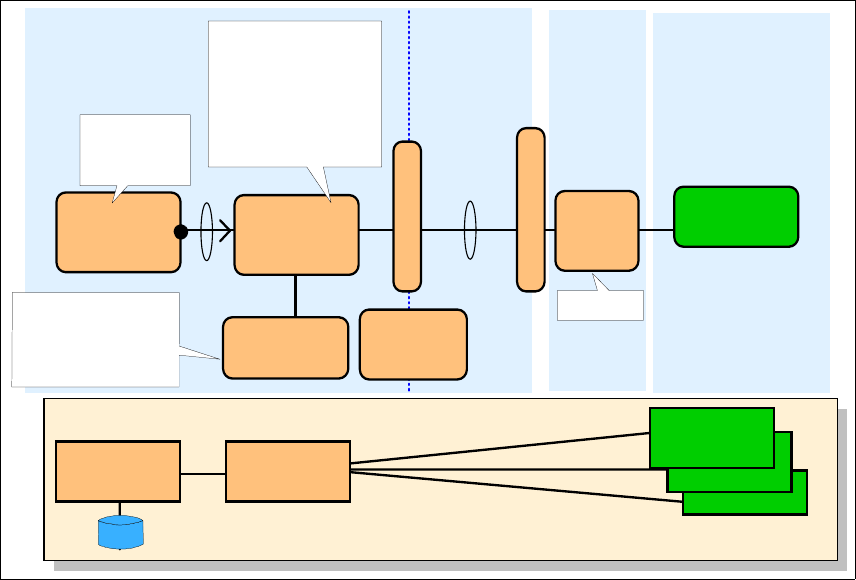
Chapter 9. Broker solutions using WebSphere Business Integration Message Broker 231
Figure 9-6 Exposed Broker Runtime pattern and product mapping
The Web Services Gateway provides a standard, secure interface to external
processes. A UDDI registry is not required, but provides an additional layer of
protection against the disruptions cause by changes in the external services. A
private or public UDDI registry could be used.
9.4 Design guidelines
When using WebSphere Business Integration Message Broker as a message
broker there are several things to consider to begin the design of the message
flow. External factors such as the characteristics of the clients and target
applications may present hard and fast restrictions. These include things such as
message transports and application interfaces supported.
Quality of Service issues must also be considered. Do you need persistent
messaging? Is the speed of the transaction more important than assured
delivery?
Source
Application
Broker
Rules
Target
Application
Partner A
Secure Zone
Demilitarized
Zone
Partner B
Inter-
enterprise
Zone
Protocol Firewall
Domain Firewall
Network
Infra-
structure
Partner
Infrastructure
Exposed
Broker
Rules
Repository
Domain QoS
Providers
App Server
Services
WebSphere Application Server -
Enterprise V5.0.2.1
+
WebSphere Application Server
Network Deployment V5.0.2.1
Private UDDI Registry
WebSphere Application Server -
Enterprise V5.0.2.1
+
WebSphere Application Server
Network Deployment V5.0.2.1
Web Services Gateway
+
WebSphere Business Integration
Message Broker V5 + CSD2
WebSphere
Application Server
V5.0.2.1
JAX-RPC
Internet
SOAP
/HTTP
SOAP
/HTTP
232 Broker Interactions for Intra- and Inter-enterprise
Once you have determined what these are, you can look into the design of the
message flows appropriate for accomplishing your task. WebSphere Business
Integration Message Broker supports a wide range of transport support and
message flow designs.
9.4.1 Selecting a transport
Consider the following features when selecting a transport to use for application
communication with WebSphere Business Integration Message Broker:
WebSphere MQ Web Services Transport: Use this when you want to allow
Web services clients to use non-persistent, non-transactional messaging to
communicate with other applications.
WebSphere MQ Real-time Transport: Use this for applications and
environments where you need to send large numbers of messages, or where
messages are to be sent to large numbers of client applications. Use this
protocol for applications that must rely on the Quality of Service provided by
TCP/IP but do not need persistent delivery.
WebSphere MQ Enterprise Transport: Use this when you require assured
delivery of messages or need to use transactional support. There are
overheads involved in using the WebSphere MQ Enterprise Transport,
therefore it does not offer the same levels of performance and scalability as
the WebSphere MQ Real-time Transport.
9.4.2 Using real-time applications
The WebSphere MQ Real-Time transport is a protocol which allows client
applications to communicate directly with the Broker via TCP/IP instead of via
intermediate queues. This direct communication, and the small overhead of the
TCP/IP flows used by the Real-Time Transport, offers potentially higher levels of
performance than the WebSphere MQ Enterprise Transport.
The Real-Time transport does not provide any facility for persistent messages or
durable subscriptions, and so is most useful for situations where data is updated
very frequently, such as updating a scoreboard for a sporting event or updating a
share price on a stock ticker. Applications that connect using WebSphere MQ
Real-time Transport and JMS use predominantly the publish/subscribe model.
WebSphere MQ Real-time support is provided using the following message flow
nodes:
Real-timeInput node: This node is used to receive messages from clients
that connect using WebSphere MQ Real-time Transport or the WebSphere
MQ Multicast Transport, and that use JMS application programming
interfaces, into a message flow.
Get Patterns: Broker Interactions for Intra- and Inter-enterprise now with the O’Reilly learning platform.
O’Reilly members experience books, live events, courses curated by job role, and more from O’Reilly and nearly 200 top publishers.

